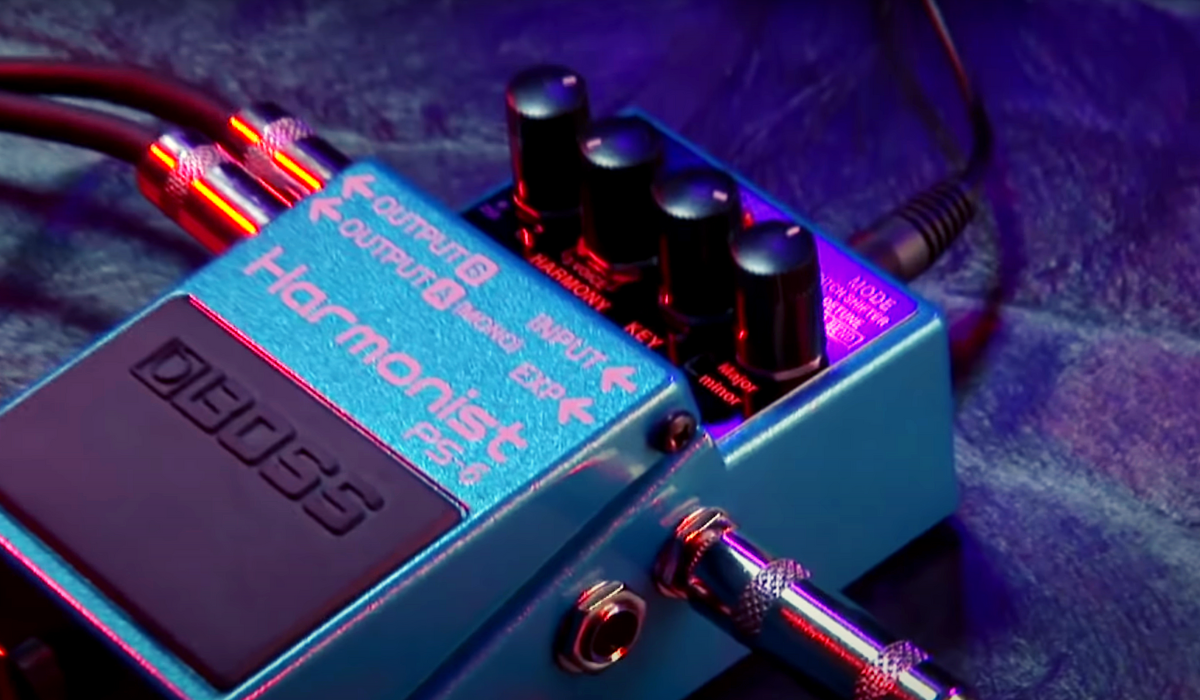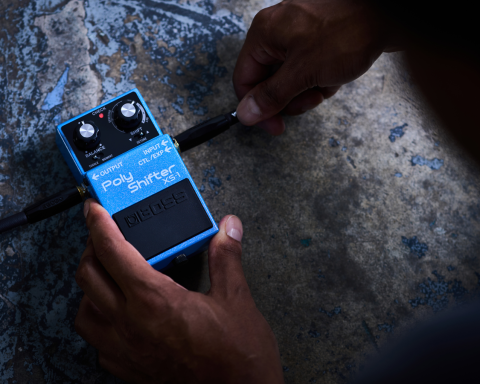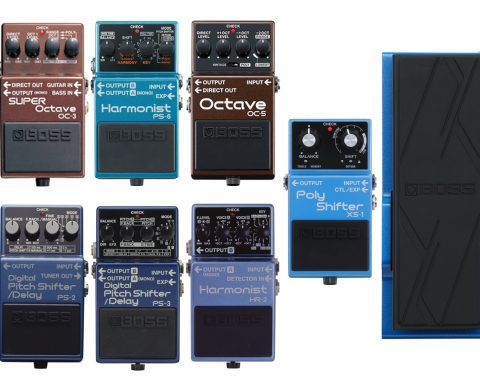The BOSS PS-6 Harmonist is a unique, feature-packed pitch-shifting effect. The pedal can create huge choirs of guitars, expand chords to new levels, mimic shimmer and chorus effects, and emulate huge pitch bends. There are myriad tonal possibilities within this pedal’s four rotary controls and single footswitch. Incorporating it into even the most straightforward pedalboard setups can unlock massive potential.
What is a Harmonist Pedal?
The BOSS PS-6 is a digital pitch shifter capable of mimicking and altering the original pitched note in several ways. Unlike the BOSS OC series, it is an expanded and complex octave pedal. The difference is that an octave pedal can transition an octave up or down from the original note. By contrast, a pitch shifter is capable of complex reinterpretation of the note in thirds, fifths, and sevenths. It can even do slight manual variations, like a chorus or vibrato pedal.
How to Use a Pitch Shifter
The Harmonist pedal features four modes. Each offers a unique effect and alters how the other three rotary controls create the effect. The Pitch Shifting mode doubles the guitar signal with one or two additional pitches. The Shift knob is a notched control. It cycles through different complementary pitches from -24 (-2 octaves) to +5 and -7 in unison, right to a shimmering +24 (+2 octaves).
The Detune mode alters the SHIFT knob to work in smaller, subtler note fractions. Rather than changing the pitch to an exact tonal value, such as a fifth or octave, the pitch is now adjusted in cents for a more delicate, off-kilter palette of tones.
"A pitch shifter is capable of complex reinterpretation of the note in thirds, fifths, and sevenths."
The Harmony mode can create complex 3-part harmonies. It even sends the complementing pitches to alternative outputs in stereo mode. In this setting, one can set the key to determine whether the Harmonist will create a major or minor accompanying harmony.
The final pedal voicing is the S-Bend mode. This one is different from the other modes, transforming the footswitch into an unlatched expression pedal. In this setting, the player can tap the footswitch to create huge digital note bends. You can also define the rise and fall time of the effect using the Balance and Key knobs.
Maximizing a Harmonist Pedal
Shimmer Chords
An exciting way to use the pitch-shifting mode of the BOSS PS-6 is to set the pedal to harmonize in perfect fifths and play chords in the upper guitar register. The PS-6 will match every note with a fifth, creating a thick, complex chord. This setting is effective when playing minor sevenths. The additional notes transform the chord into a minor 11 chord, full of cascading otherworldliness.
"An exciting way to use the pitch-shifting mode of the BOSS PS-6 is to set the pedal to harmonize in perfect fifths and play chords in the upper register."
Morello Style
Tom Morello is famous for his recognizable method of blending sliding guitar parts with digital octave slides. It can be a great way to expand solos into octaves beyond a standard guitar’s range while quickly returning to the instrument’s normal range.
S-Bend mode allows the player to access additional octaves with the footswitch operating in an unlatched mode. When the pedal gets suppressed, the note slides up an octave. Set the rise and fall time to a fast but realistic speed to emulate a natural-sounding slide. This way, the octave slides are similar to suppressing and releasing an expression pedal.
Detuned Chorus
The PS-6 can create complex harmonies and accurate pitch-shifted notes. Conversely, one of its more unique features is Detune mode, which allows for subtle microtonal alterations in pitch. This can be a fantastic tool for creating rich, broad-sounding chorus tones.
To craft a chorus-like tone using the PS-6, select the Detune mode. Then set the Balance knob to around one or two o’clock so the clean signal is audible above the detuned pitch-shifted signal. For a super-rich chorus tone, set the Shift knob fully counterclockwise. At this setting, the shift control adds +15 cents and -15 cents. Alongside the clean signal, these add a three-dimensional thickness to chords and picked guitar parts.
"Detune mode allows for microtonal alterations in pitch. This can be a fantastic tool for creating rich, broad-sounding chorus tones."
Cascading Solos
For guitarists looking to walk on the wilder side of tone creation, the PS-6 can unlock some unusual but usable sounds. One of these is a cascading tone-shifting solo tone using the S-Bend mode of the PS-6. Once selected, set the rise time to be extremely short but the fall time very long. Play and note, then tap the footswitch. The note immediately shifts up an octave while sliding back to the original pitch.
The key to this technique is to play as the pedal returns to pitch. It will retune every note played, but it will still be sliding as it does so, creating a cacophony of nearly random notes. Tap the pedal again while playing, and the notes will return to the correct octave pitch. Do this occasionally during the solo to maintain an ‘in tune’ nature to the solo.
8-Bit Guitar
There is quite a lot of processing involved to create the complex intervals that the PS-6 is capable of. Therefore, the shifted notes can sound more digital on more complex intervals. For example, octaves can sound relatively authentic, especially mixed in balance with a clean signal. By contrast, fourths and sixths have a more digital, synth-like tone.
This sound can transform the guitar into an 8-bit video game version of itself. To achieve this sort of sound, select the Pitch Shift mode, and set the pitch to something unusual, like a third or sixth. Next, turn the Balance knob fully clockwise so that the only signal passing through is the resampled, pitch-shifted tone. The guitar will now sound extremely undynamic and, in the upper register especially, will have a synthetic lo-fi tone.
A Choir of Guitars
A fantastic way to lift guitar solos and create vast walls of tone is to use the three-part harmony function of the PS-6. In this mode, set the Key knob to the key of the guitar solo. Then set the Harmony knob fully clockwise for a three-part harmony in either a third and fifth or third and negative fourth harmony. Use a second amplifier to send a blend of clean signal and one of the harmonies to each amp, creating a wide, three-dimensional choir of guitars.
"A fantastic way to lift guitar solos and create vast walls of tone is to use the three-part harmony function of the PS-6."
An Advanced Creative Tool
The BOSS Harmonist PS-6 is an advanced creative tool for everything from subtle accompaniments to wild detuned note bends. It’s versatile, tonally comprehensive, and a lot of fun. The Harmonist can do the fundamental jobs of a simple octave pedal. But it’s also a secret weapon, unleashing the power of an extra guitar player whenever needed.






